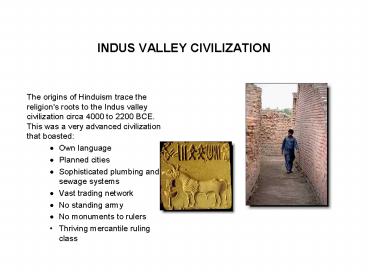INDUS VALLEY CIVILIZATION - PowerPoint PPT Presentation
1 / 21
Title:
INDUS VALLEY CIVILIZATION
Description:
... first century AD CATEGORIZING HINDUISM IS CONFUSING Brahma the Creator who is continuing to create new realities Vishnu ... of ten incarnations ... – PowerPoint PPT presentation
Number of Views:174
Avg rating:3.0/5.0
Title: INDUS VALLEY CIVILIZATION
1
INDUS VALLEY CIVILIZATION
- The origins of Hinduism trace the religion's
roots to the Indus valley civilization circa 4000
to 2200 BCE. This was a very advanced
civilization that boasted - ? Own language
- ? Planned cities
- ? Sophisticated plumbing and sewage systems
- ? Vast trading network
- ? No standing army
- ? No monuments to rulers
- Thriving mercantile ruling class
2
Aryan Invasions
- The development of Hinduism was influenced by
many invasions over thousands of years. The major
influences occurred when light-skinned nomadic
"Aryan" Indo-European tribes invaded Northern
India (circa 1500 BCE) from the steppes of Russia
and Central Asia. They brought with them their
religion of Vedism. These beliefs mingled with
the more advanced, indigenous Indian native
beliefs, often called the "Indus Valley culture."
3
The Vedic Period
The predominance of female figurines and seals
depicting a horned goddess by the Indus People is
generally regarded as evidence of the worship of
a mother goddess who presided over fertility and
birth and who may have acted as guardian and
protector of the dead.
4
UPANISHADAS
- They are a continuation of the Vedas, and
were written between 800 and 400 BCE. - They elaborate on how the soul (Atman) can
be united with the ultimate truth (Brahman)
through contemplation and mediation, as well as
the doctrine of Karma-- the cumulative effects of
a persons actions.
5
MAHABHARATA BHAGAVAD GITA RAMAYANA
- The Mahabharata, were written 540 to 300
BCE, - The Bhagavad Gita is the sixth book of the
Mahabharata. It is a poem describing a
conversation between a warrior Arjuna and the God
Krishna. It is an ancient text that has become
central to Hinduism - Another important text is the Ramayana. It
is a moving love story with moral and spiritual
themes. It is dated to the first century AD
6
CATEGORIZING HINDUISM IS CONFUSING
Polytheistic - one which worships multiple
deities gods and goddesses. Monotheistic
religion, because it recognizes only one supreme
God Brahman, that all reality is a unity.
Trinitarian because Brahman is simultaneously
visualized as a triad Brahma, the Creator
Vishnu, (Krishna) the Preserver and Shiva, the
Destroyer
7
Brahma the Creator who is continuing to create
new realities
8
Vishnu, (Krishna) the Preserver, who preserves
these new creations.
- Whenever dharma (eternal order,
righteousness, religion, law and duty) is
threatened, Vishnu travels from heaven to earth
in one of ten incarnations.
9
Shiva, the Destroyer, is at times compassionate,
erotic and destructive.
10
URBAN HINDUS
- Most urban Hindus follow one of two major
divisions within Hinduism - Vaishnavaism which generally regards Vishnu as
the ultimate deity - Shivaism which generally regards Shiva as the
ultimate deity.
11
RURAL HINDUS
- Many rural Hindus worship their own village
goddess or an earth goddess. She is believed to
rule over fertility and disease -- and thus over
life and death. - The priesthood is less important in rural
Hinduism non-Brahmins and non-priests often
carry out ritual and prayer there.
12
SAMSARA
- Hindus believe in the repetitious
Transmigration of the Soul. This is the transfer
of one's soul after death into another body. This
produces a continuing cycle of birth, life, death
and rebirth through their many lifetimes. It is
called samsara.
13
KARMA
- Karma is the accumulated sum of ones good and
bad deeds. Karma determines how you will live
your next life. Through pure acts, thoughts and
devotion, one can be reborn at a higher level.
Eventually, one can escape samsara and achieve
enlightenment. Bad deeds can cause a person to be
reborn as a lower level, or even as an animal.
The unequal distribution of wealth, prestige,
suffering are thus seen as natural consequences
for one's previous acts, both in this life and in
previous lives.
14
Dharma
- Dharma is to fulfill your moral duty in this
life. By fulfilling your Dharma and producing
only good Karma you can move up the caste system
and could release you from Samsara.
15
CASTE SYSTEM
- The enslavement of the dark skinned people of
the Indus Valley is thought to have laid the
foundation of the caste system. The caste system
was further enforced by the Hindu belief of
Karma. Bad deeds can cause a person to be reborn
as a lower level, or even as an animal. The
unequal distribution of wealth, prestige,
suffering are thus seen as natural consequences
for one's previous acts, both in this life and in
previous lives.
16
Atman
- Atman is the soul that is reincarnated. Atman
is the part of god in every living thing. The
purpose of life is to unite Atman with Brahman.
17
MOKSA
- The main goal for those who renounce the world
is - Moksa or liberation from "samsara," This is
uniting Atman with Brahman. Moksa is considered
the supreme end of mankind.
18
Maya
- Maya is the illusionary world created by our
senses. This veil of illusion makes people
believe they are separate from Brahma
19
MEDITATION
- Meditation is often practiced, with Yoga being
the most common. The goal of meditation is to
help break-through the Maya and to seek Brahman.
20
Prayer Offerings
Offerings are also often used to assist the
Poor Other activities include daily devotions,
public rituals, and puja, a ceremonial dinner
for a God.
21
TOLERANT ELASTIC
- Hinduism has a deserved reputation of being
highly tolerant of other religions. Hindus have a
saying "Ekam Sataha Vipraha Bahudha Vadanti,"
which may be translated "The truth is One, but
different Sages call it by Different Names"































